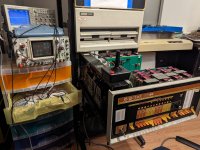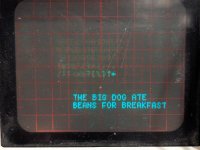Vince and I are shortly being joined by Doug to play with Vince's 8/E and 12, and maybe even an 8/I. Earlier in the week, we spent much of the time debugging a VC8E clone that Vince designed. The basics of it aren't that complex, but to support different displays, some of which have color and storage support, there are lots of polarity, voltage, and timing considerations that must be made. We've been trying to find ways of better testing the timing portions, and have found that the DONE flag does not always get set after an operation. Unfortunately, neither the oscilloscope nor logic analyzer seem to have the depth we need to see the entire issue, as it seems nondeterministic and thus triggering the test equipment is challenging.
View attachment 1262938
View attachment 1262940
I would share my DSLR photos, but the forum won't let me upload them due to their size... So, in the meantime, you'll have to enjoy the not so great photos of the Tek 464 rather than the nice photos of the Tek 611. The 611 is a mighty fine display!
We put the VC8E aside to work on Vince's very elegant 5 paddle card MM8I solution. It turns out that it requires very few components to fill in the rest of the 32k memory space on an 8/I or 12—not dissimilar from the Omnibus memory board design. We've been experimenting with the 12, but the 8/I shares the same external memory bus architecture. We still found bugs, but these will be fixed in another respin of the board set.
View attachment 1262939
For those planning on showing up to VCF MW, Vince is planning to bring some show and tell, but due to lack of overhead space on the plane, the PDP-12 will have to remain at home until next year.
In the meantime, stay tuned for more adventures from the trio.





